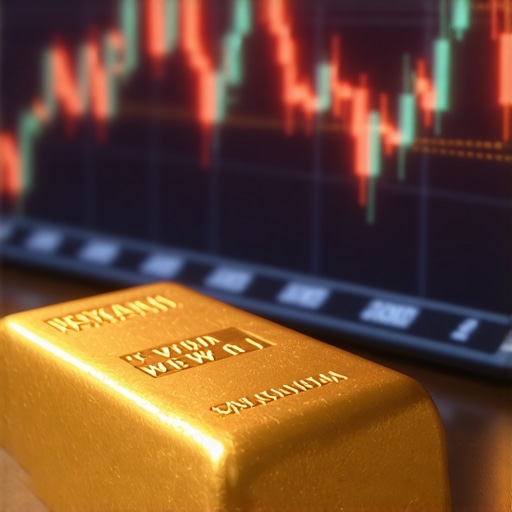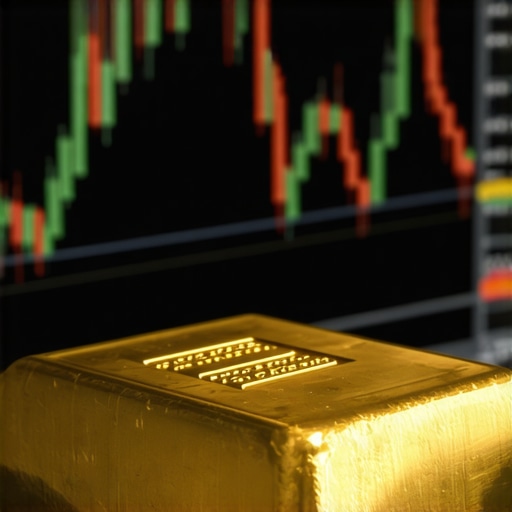Forecasting the Trajectory of Gold Prices in 2025: An Expert Analysis
As we approach the mid-decade mark, understanding the complex interplay of macroeconomic, geopolitical, and market-specific factors becomes essential for investors targeting gold as a strategic asset. Gold, long revered as a hedge against inflation and currency depreciation, faces nuanced dynamics that could redefine its valuation landscape in 2025. This analysis synthesizes recent trends, expert predictions, and emerging market signals to offer a comprehensive outlook on the future of gold prices.
Deciphering the Key Drivers Influencing Gold Price Movements in 2025
How Will Central Bank Policies Shape Gold’s Market Trajectory?
Central banks continue to wield significant influence over gold prices through their gold reserve management and monetary policies. Notably, the recent uptick in gold acquisitions by major central banks signals a strategic shift towards diversification amid ongoing geopolitical tensions. According to a recent report from the World Gold Council, central bank gold purchases could further underpin prices, especially if monetary tightening persists globally.
Furthermore, the evolution of quantitative easing and interest rate policies in advanced economies will modulate gold’s appeal as a non-yielding asset. When real interest rates are low or negative, gold tends to outperform, making the outlook for 2025 contingent upon monetary policy stances.
Market Sentiments and Investment Strategies for 2025
Investors should consider diversifying their portfolios through a blend of physical gold, ETFs, and mining stocks. For example, leveraging gold ETFs and mutual funds can offer liquidity and exposure to global gold demand trends. Meanwhile, physical gold remains a cornerstone for wealth preservation, especially in regions experiencing currency volatility.
Advanced Considerations: Gold Supply-Demand Dynamics and Technological Innovations
Beyond macroeconomic factors, supply-demand imbalances—such as mine production levels and consumer jewelry demand—also influence pricing. Emerging technologies, including blockchain-based gold trading platforms, are poised to enhance transparency and liquidity, potentially impacting market efficiency in 2025.
What Are the Nuanced Risks and Opportunities for Gold Investors in 2025?
While gold retains its status as a safe haven, geopolitical upheavals or unexpected economic shocks could temporarily distort its valuation. Conversely, innovations like gold-backed digital assets or central bank digital currencies may open new avenues for exposure and hedging strategies.
To explore sophisticated investment techniques, consider examining proven gold trading secrets that maximize returns amid market volatility.
For an authoritative perspective, consult the World Gold Council’s latest research on gold market trends and forecasts.
Engage with the gold investment community and share insights to refine your 2025 strategy—your expertise could be pivotal in navigating the evolving landscape of precious metals.
Unveiling the Nuances of Gold Market Volatility in 2025
While gold is often regarded as a stable store of value, the intricacies of its pricing dynamics reveal a more complex picture, especially as we navigate 2025. Investors need to understand that short-term fluctuations can present both risks and opportunities. Market sentiment, driven by geopolitical developments and economic data releases, frequently sways gold prices in unpredictable ways. To adapt, investors should leverage advanced analytical tools, such as proven gold trading secrets, which incorporate technical indicators and sentiment analysis for more informed decision-making.
Why Should Investors Question Conventional Wisdom About Gold’s Safe-Haven Status?
Many believe that gold’s safe-haven reputation guarantees protection during economic downturns. However, recent market behavior suggests that its performance can sometimes diverge from expectations, especially during periods of unconventional monetary policies or technological disruptions. For example, innovations like blockchain-based gold trading platforms are transforming liquidity and transparency, potentially altering traditional risk assessments. According to a comprehensive report from the World Gold Council, understanding the evolving nature of gold’s role in diversified portfolios is crucial for 2025.
How Can Sophisticated Investors Use Quantitative Models to Forecast Gold Prices in 2025?
Quantitative modeling, incorporating macroeconomic variables, supply-demand fundamentals, and market sentiment, offers a valuable framework for forecasting. Machine learning algorithms and econometric techniques can identify subtle patterns and correlations that human analysis might miss. For instance, tracking gold futures data along with geopolitical risk indices can enhance predictive accuracy. Implementing these models requires a deep understanding of market mechanics but can significantly improve timing and risk management strategies.
Engaging with expert analyses and continuously refining models based on real-time data is essential—remember, no single indicator guarantees success. As the market evolves, so should your approach.
Interested in diversifying your holdings? Consider exploring gold ETFs and mutual funds for flexible exposure that can adapt to market shifts while providing liquidity and broad market participation.
Harnessing Technological Disruptions to Forecast Gold Price Trends in 2025
Emerging technologies are revolutionizing the way investors and analysts approach gold markets. Blockchain platforms, for instance, are not only enhancing transparency but also enabling fractional ownership and real-time trading, which can significantly influence liquidity and price discovery mechanisms. According to a detailed study by the World Gold Council, technological innovation is poised to reshape market dynamics, reducing transaction costs and broadening access to gold investments globally.
Furthermore, the integration of artificial intelligence (AI) and machine learning models into market analysis allows for the identification of subtle, non-linear relationships between macroeconomic indicators and gold prices. These sophisticated models can process vast datasets—ranging from geopolitical risk indices to currency fluctuations—delivering more precise forecasts for 2025 and beyond. For investors, understanding these technological trends is crucial for developing resilient, data-driven strategies that capitalize on market movements.
What are the principal challenges and opportunities presented by these technological advances for gold investors?
On the challenge side, the rapid pace of innovation introduces volatility and unpredictability, especially as new trading platforms and digital assets emerge. The regulatory landscape is also evolving, which could impact market stability and investor confidence. Conversely, opportunities abound in leveraging blockchain-based gold tokens and digital currencies backed by physical reserves. These innovations not only enhance security and liquidity but also open new avenues for hedging and diversification, especially in a world increasingly driven by digital finance.
To deepen your understanding, explore comprehensive reports like the Gold Council’s analysis of digital gold assets which provides insights into how these innovations could influence prices and market structure in 2025.
Integrating Macroeconomic and Geopolitical Factors into Advanced Gold Price Forecasting Models
While technological innovations are transforming market mechanics, the core of accurate gold forecasting still hinges on macroeconomic and geopolitical analysis. Investors employing advanced quantitative models incorporate variables such as inflation expectations, currency strength, and geopolitical risk indices to generate nuanced forecasts. Econometric tools, combined with machine learning algorithms, can detect evolving patterns—such as the impact of emerging trade tensions or monetary policy shifts—allowing investors to anticipate price movements with greater confidence.
For example, tracking the trajectory of real interest rates in tandem with geopolitical escalation indices can reveal potential inflection points for gold prices. Institutions like the International Monetary Fund publish detailed data that can feed into these models, enhancing predictive accuracy and strategic planning.
Engage with expert analyses and leverage these advanced tools to refine your investment approach as 2025 approaches. Remember, combining technological innovation with macroeconomic rigor offers the most comprehensive outlook for gold investors.
How Can Investors Balance Short-term Volatility with Long-term Strategic Goals in Gold Investment?
Balancing immediate market fluctuations with overarching investment objectives requires a disciplined, multifaceted approach. Employing diversified strategies—such as allocating assets across physical gold, ETFs, and digital assets—can cushion against short-term volatility while maintaining exposure to long-term growth. Additionally, employing risk management techniques like options hedging and stop-loss orders can mitigate downside risk during turbulent periods.
Most importantly, maintaining an adaptive mindset—regularly updating models and staying informed on technological and macroeconomic developments—ensures resilience. For personalized guidance, consulting with financial advisors specialized in precious metals can help tailor strategies aligned with your risk appetite and objectives.
Harnessing Quantum Computing to Decode Gold Market Complexities in 2025
As the financial ecosystem evolves, quantum computing emerges as a revolutionary tool capable of processing vast datasets and modeling intricate market variables with unprecedented accuracy. For gold investors, leveraging quantum algorithms can refine predictive models by analyzing macroeconomic indicators, geopolitical risks, and supply-demand dynamics simultaneously. According to a recent report by the Quantum Economic Development Consortium, integrating quantum computing into financial modeling could significantly enhance forecast precision, especially in volatile markets like precious metals.
Synergizing Geopolitical Intelligence with Market Analytics for Superior Predictions
In an era where geopolitical shifts can swiftly impact commodity valuations, advanced analytics now incorporate real-time geopolitical intelligence. Tools that synthesize news sentiment analysis, diplomatic developments, and sanction announcements enable investors to anticipate market movements with heightened sensitivity. This multidimensional approach transforms traditional models into dynamic systems capable of adjusting forecasts as new information emerges, thus offering a strategic advantage in navigating 2025’s uncertain terrain.
What are the most effective methods for integrating geopolitical risk assessments into gold price forecasts?
Combining geopolitical risk indices with machine learning-driven sentiment analysis creates a powerful framework for anticipatory modeling. For example, utilizing structured data from sources like the Global Peace Index alongside unstructured news feeds analyzed through natural language processing (NLP) can identify early signals of market stress. Experts recommend continuous model recalibration to maintain relevance amid rapidly changing geopolitical landscapes. For detailed methodologies, consult specialized publications such as the World Gold Council’s research on geopolitical influences on gold.
To stay ahead, investors should consider deploying these integrated models within their strategic toolkit, enabling proactive decision-making in 2025’s unpredictable environment.
Innovative Financial Instruments Shaping the Future of Gold Investment
The emergence of novel financial products, such as tokenized gold assets and smart contract-enabled vaults, is redefining liquidity and accessibility. These innovations allow fractional ownership and instant settlement, reducing transaction costs and barriers to entry. According to a study by the Cambridge Centre for Alternative Finance, the adoption of blockchain-based gold tokens could democratize access to precious metals, fostering a more resilient and transparent market ecosystem in 2025.
Investors should explore integrating these instruments into diversified portfolios, leveraging their flexibility to hedge against inflation and currency fluctuations. Engaging with platforms that offer secure, regulated digital gold trading can also mitigate counterparty risks inherent in emerging markets.
Integrating Socioeconomic Trends with Quantitative Models for Holistic Forecasting
Beyond macroeconomic and geopolitical factors, socioeconomic shifts—such as demographic changes and consumer behavior—play a critical role in shaping gold demand. Advanced models now incorporate data from social media analytics, consumer sentiment surveys, and demographic statistics to predict long-term demand trends. For instance, rising urbanization and wealth accumulation in emerging markets could bolster jewelry and investment demand, influencing prices upward.
Utilize comprehensive datasets and sophisticated econometric techniques to capture these nuanced drivers, thereby enhancing your strategic foresight for 2025. Institutions like the IMF provide valuable resources to inform such integrative models.
How can investors harness big data analytics to predict gold price trends with higher confidence?
Employing big data analytics involves aggregating diverse sources—market data, news feeds, social media, and economic indicators—and applying machine learning algorithms to detect hidden patterns. Techniques such as deep learning neural networks can process unstructured data, providing real-time insights that improve forecast accuracy. For example, sentiment analysis on social media platforms may reveal emerging investor behaviors before they are reflected in prices, offering a critical edge in dynamic markets.
To optimize your predictive capabilities, consider partnering with data science experts and adopting advanced analytics platforms designed specifically for commodity markets. This approach ensures your strategies are rooted in data-driven insights, enabling resilience amidst market volatility.
Expert Insights & Advanced Considerations
Emerging Technologies Will Revolutionize Gold Trading Platforms
Investors should monitor how blockchain-based trading and fractional ownership models will reduce transaction costs and increase market transparency. These technologies are poised to reshape liquidity and price discovery mechanisms, offering new opportunities for strategic positioning in 2025.
Central Bank Policies Will Continue to Influence Gold Pricing Dynamics
Ongoing central bank diversification strategies, including increased gold reserve acquisitions, are likely to underpin prices. Monitoring these shifts provides a competitive edge for sophisticated investors aiming to anticipate market movements.
Macroeconomic Models Are Becoming More Sophisticated with AI Integration
Utilizing machine learning algorithms that incorporate macroeconomic indicators, geopolitical risks, and supply-demand fundamentals enhances forecast accuracy. Advanced models can identify subtle market patterns, enabling proactive risk management.
Geopolitical Risk Analysis Is Critical for Precise Price Predictions
Integrating real-time geopolitical intelligence through sentiment analysis and risk indices allows investors to anticipate market shocks. This multidimensional approach is essential for navigating 2025’s uncertain terrain effectively.
Digital Gold and Tokenized Assets Will Offer New Diversification Channels
Emerging financial instruments such as blockchain-backed gold tokens and digital currencies backed by physical reserves will broaden access and liquidity, creating innovative hedging strategies in a rapidly digitizing market landscape.
Curated Expert Resources
- World Gold Council Research: Offers comprehensive insights into gold market trends, central bank activities, and technological innovations shaping the market.
- Gold Council’s Digital Asset Analysis: Provides in-depth analysis of digital gold tokens and blockchain innovations influencing supply and demand dynamics.
- IMF Economic Data: Essential macroeconomic indicators and geopolitical risk assessments supporting quantitative modeling efforts.
- Quantum Economic Development Consortium Reports: Insights into how quantum computing is transforming market modeling and forecast precision.
- Natural Language Processing (NLP) in Geopolitical Analysis: Guides on integrating news sentiment and diplomatic development data into predictive models.
Final Expert Perspective
As we approach 2025, the landscape of gold investment is evolving rapidly, driven by technological innovations, macroeconomic shifts, and geopolitical dynamics. Staying ahead requires a sophisticated understanding of these factors and leveraging advanced analytical tools. Gold remains a vital component of diversified portfolios, but its role is transforming in the digital age with new instruments and platforms. Engage deeply with authoritative resources, refine your strategies continually, and consider integrating cutting-edge technologies like AI and blockchain into your investment approach. Your expertise and proactive engagement will be key to capitalizing on the opportunities that 2025 will present in the precious metals market. For those committed to mastery, exploring the latest research and engaging with industry leaders will ensure your strategies remain resilient and forward-looking.










